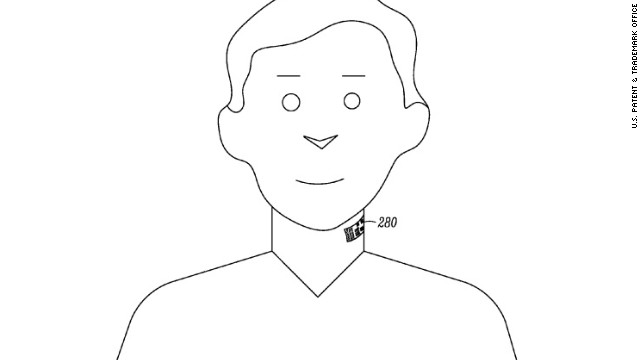Malik
Superstar

(CNN) -- It looks like Google Glass was just the beginning. Google now appears to be aiming a few inches lower, working on a temporary electronic tattoo that would stick to the user's throat.
Google-owned Motorola Mobility has filed for a patent, published last week, for a system "that comprises an electronic skin tattoo capable of being applied to a throat region of a body."
The patent says the tattoo would communicate with smartphones, gaming devices, tablets and wearable tech like Google Glass via a Bluetooth-style connection and would include a microphone and power source. The idea is that wearers could communicate with their devices via voice commands without having to wear an earpiece or the the Glass headset.
And how's this for future tech? It could even be used as a lie detector.
"Optionally, the electronic skin tattoo can further include a galvanic skin response detector to detect skin resistance of a user," the 10-page document reads. "It is contemplated that a user that may be nervous or engaging in speaking falsehoods may exhibit different galvanic skin response than a more confident, truth telling individual."
"Galvanic" is a reference to the way some surfaces, even skin, conduct electricity.
Google explains mystery barge
In images attached to the filing, the tattoo appears to be between a postage stamp and a Band-Aid in size. The filing says that in addition to sticking via an adhesive to the throat, the tattoo could go on a collar or a band around the user's neck.
Other possible uses include making both incoming and outgoing audio clearer. That could mean anything from making smartphone conversations clearer in a crowded room to being able to listen to music without earphones.
And we can't quite figure out the use case for this one, but: "the electronic tattoo can also be applied to an animal as well."
Digital tattoos and mind-reading headphones
With Google Glass, the company has moved to be at the forefront of the rapidly emerging trend in wearable tech. Glass is a wearable computer with a smartphone-like display that lets users text, browse the Web, take photos and run other apps, all hands free.
The latest version rolling out to field testers includes an ear bud, in response to complaints from some that the first version's bone-conduction sound system didn't work well. It's not hard to envision the throat tattoo as an eventual answer to that complaint.
Other wearable tech either on the market or the horizon includes smartwatches from Samsung and Sony, with Google, Apple and Microsoft expected to join the fray soon.
A Motorola spokesman said the company has no comment about the patent filing at this time.
 another use of it was to be tried as a 'lie detector' where the sensors would pick up on changes on the skin of the users throat that would respond a certain way when lying. Secondly, just because Google patents it, doesn't mean it will ever be up for commercial use. For all you know, this can be sold to the military, law firms, etc and left at that.
another use of it was to be tried as a 'lie detector' where the sensors would pick up on changes on the skin of the users throat that would respond a certain way when lying. Secondly, just because Google patents it, doesn't mean it will ever be up for commercial use. For all you know, this can be sold to the military, law firms, etc and left at that. 
 and still have money to barter & purchase goods & services...)
and still have money to barter & purchase goods & services...)

